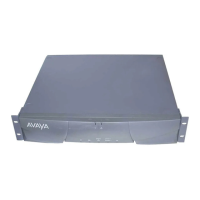Analog Tie Trunk Back-to-Back Testing
Issue 1 May 2002
5-27555-233-143
11. At the cross-connect field, disconnect outside trunk facilities from the tie
trunk ports and mark the disconnected wires for reconnecting the tie trunk
ports to their normal configuration later. The D impact tool (AT-8762) is
required to perform this step.
12. Use jumper wires (DT 24M-Y/BL/R/G and DT 24P-W/BRN) and the D
impact tool to connect wiring between the two ports assigned in step 9 at
the cross-connect field. For example, if the two ports on the analog Tie
Trunk circuit pack are port 1 and 2, connect the wirings as shown below:
13. Check all wirings to verify good connections between the two test ports.
14. Place a call from one voice terminal to another voice terminal using the tie
trunk ports assigned. Dial TAC and extension. For example, if TAC of tie
trunk group is 110 and station number is 5012, then dial 110 5012. If the
call cannot be made, either one of these ports could be defective. There
are four ports on the TN760. Try different combinations to determine
defective ports.
15. If there is a defective port on the circuit pack, try to switch to an unused
port. If every port is normally used, then replace the circuit pack.
16. Disconnect the jumpers between two ports. Then use administration
terminal and trunk printouts to restore every trunk-group change to normal
values.
Port 1
(t1 stan)
(E&M)
Port 2
(t1 comp)
(E&M)
T1 connected to T12
R1 connected to R12
T11 connected to T2
R11 connected to R2
E1 connected to M2
M1 connected to E2
Table 5-4. Carrier Lead Appearances MDF
110 Connecting Block
Terminals CO Trunk TN74 7 Tie Trunk TN76 0
1T1T1
2R1R1
3T11
Continued on next page

